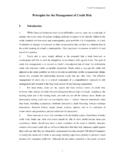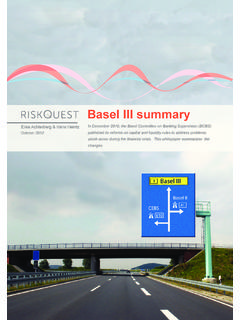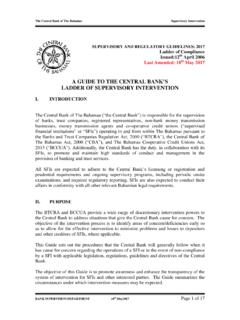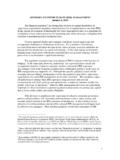Transcription of Basel Committee on Banking Supervision …
1 Basel Committee on Banking Supervision Consultative Document Guidelines Guidance on accounting for expected credit losses Issued for comment by 30 April 2015. February 2015. This publication is available on the BIS website ( ). bank for International Settlements 2015. All rights reserved. Brief excerpts may be reproduced or translated provided the source is stated. ISBN 978-92-9197-043-8 (print). ISBN 978-92-9197-042-1 (online). Contents Principles underlying this document .. 1. Objective and scope .. 2. Supervisory requirements for sound credit risk practices that interact with expected credit loss measurement .. 5. Supervisory evaluation of credit risk practices, accounting for expected credit losses and capital adequacy.
2 21. Appendix: Supervisory requirements specific to jurisdictions applying IFRS .. 24. Guidance on accounting for expected credit losses iii Guidance on accounting for expected credit losses Principles underlying this document This supervisory guidance is structured around 11 principles. Supervisory requirements for sound credit risk practices that interact with expected credit loss measurement Principle 1: A bank 's board of directors (or equivalent) and senior management are responsible for ensuring that the bank has appropriate credit risk practices, including effective internal controls, commensurate with the size, nature and complexity of its lending exposures to consistently determine 1.
3 Allowances in accordance with the bank 's stated policies and procedures, the applicable accounting framework and relevant supervisory guidance. Principle 2: A bank should adopt, document and adhere to sound methodologies that address policies, 2. procedures and controls for assessing and measuring the level of credit risk on all lending exposures. The robust and timely measurement of allowances should build upon those methodologies. Principle 3: A bank should have a process in place to appropriately group lending exposures on the basis of shared credit risk characteristics. Principle 4: A bank 's aggregate amount of allowances, regardless of whether allowance components are determined on a collective or an individual basis, should be adequate as defined by the Basel Core Principles, which is an amount understood to be consistent with the objectives of the relevant accounting requirements.
4 Principle 5: A bank should have policies and procedures in place to appropriately validate its internal credit risk assessment models. Principle 6: A bank 's use of experienced credit judgment, especially in the robust consideration of forward-looking information that is reasonably available and macroeconomic factors, is essential to the assessment and measurement of expected credit losses. Principle 7: A bank should have a sound credit risk assessment and measurement process that provides it with a strong basis for common systems, tools and data to assess and price credit risk , and account for expected credit losses. Principle 8: A bank 's public reporting should promote transparency and comparability by providing timely, relevant and decision-useful information.
5 1. The term allowances includes allowances on loans and provisions on loan commitments and financial guarantee contracts. 2. The term lending exposures includes loans, commitments and guarantees. Guidance on accounting for expected credit losses 1. Supervisory evaluation of credit risk practices, accounting for expected credit losses and capital adequacy Principle 9: Banking supervisors should periodically evaluate the effectiveness of a bank 's credit risk practices. Principle 10: Banking supervisors should be satisfied that the methods employed by a bank to determine allowances produce a robust measurement of expected credit losses under the applicable accounting framework.
6 Principle 11: Banking supervisors should consider a bank 's credit risk practices when assessing a bank 's capital adequacy. This guidance is intended to set forth supervisory requirements on accounting for expected 3. credit losses that do not contradict applicable accounting standards established by standard setters. Objective and scope 1. The objective of this paper is to set out supervisory requirements on sound credit risk practices associated with the implementation and ongoing application of expected credit loss (ECL) accounting models. Such practices include all aspects of a bank 's procedures for managing credit risk . However, for the purpose of this paper, the scope of credit risk practices is limited to those practices affecting the assessment and measurement of allowances under the applicable accounting framework.
7 2. In June 2006, the Basel Committee on Banking Supervision issued supervisory guidance on Sound credit risk Assessment and Valuation for Loans to address how common data and processes related to loans may be used for assessing credit risk , accounting for loan impairment and determining 4. regulatory capital requirements. This document, once finalised, will replace the Committee 's June 2006. guidance. 3. Historically, the incurred-loss model served as the basis of accounting and was implemented with significant differences from jurisdiction to jurisdiction, and amongst banks within the same jurisdiction, due to the development of national, regional and entity-specific practices.
8 In revising its 2006 guidance on the verge of a global transition to ECL accounting frameworks, the Committee emphasises the importance of a high-quality, robust and consistent implementation of ECL accounting frameworks across all jurisdictions. With regard to consistency, the Committee recognises that differences exist between ECL accounting frameworks, across jurisdictions. The revised guidance does not intend to drive convergence between these accounting frameworks, but does aim to drive consistent interpretations and practices, where there are commonalities and when the same accounting framework is applied. 4. The requirements described in the main section of this paper are equally applicable under all accounting frameworks.
9 For jurisdictions in which ECL accounting frameworks are not required, the 3. Representatives of the International Accounting Standards Board have been provided with the opportunity to comment on this document and have not identified any aspects of it that would prevent a bank from meeting the impairment requirements of IFRS 9 Financial Instruments. 4. Available at 2 Guidance on accounting for expected credit losses Committee expects that the relevant aspects of this guidance related to sound credit risk practices will be applied. 5. The move to ECL accounting frameworks by accounting standard setters shifts the Banking industry forward in resolving the weakness identified during the financial crisis that credit loss recognition was too little, too late.
10 The development of ECL accounting frameworks is also consistent with the April 2009 call by the G20 Leaders for accounting standard setters to strengthen accounting 5. recognition of loan loss provisions by incorporating a broader range of credit information . 6. As demonstrated during the financial crisis, the financial condition of a bank is highly sensitive to rapid increases in credit risk . Therefore, appropriately determining how, when and in what amount to recognise the effects of increases in credit risk should be a priority for all stakeholders in the Banking industry, including bank directors and management, supervisors, investors and other users of banks'.


















